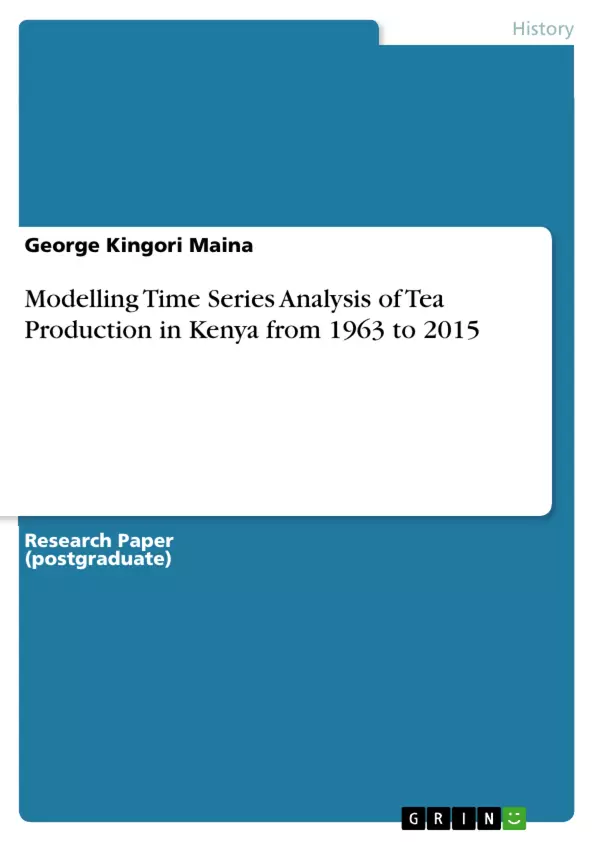Tea is the leading export cash crop and a highly consumed beverage in Kenya. Small scale farmers are more than large scale farmers in Kenya. However, they own small sizes of land which is a limiting factor to tea production. Analysis of trends is an aspect of technical analysis that tries to predict the future movement of stock based on past data. The main objectives of this study is To construct a suitable time series model for the data, To determine the correlation between production and size of land, To forecast tea production Examples of analysis of trends are total monthly sales receipts in a departmental store and total monthly production by company.
This research project was on the trends of tea production and area under tea that are collected annually since 1963 to 2015 and to construct a time series model of a suitable order for the process. The large scale size of land mean is 34882.04 hectares and the average small scale size of land is 4563.25 hectares .For the stationarity of the data the Dickey-Fuller test (ADF); Dickey-Fuller = -1.9254, Lag order = 3, p-value = 0.6045.The correlation of the large scale and small scale holders is; 0.9588537 and 0.9339925 hence strong linear relationship . The best possible models for modelling large scale is ARIMA (2, 1, 0) with Akaike Information Criterion (AIC) of 1885.73 and for Small scale farmers it ARIM(1,1,0) with AIC of 1915.76. The rate of change of the predicted tea production is 0.97 which is a very low rate. These values show that in the next 20 years there will be no significant changes in tea production in Kenya.
Inhaltsverzeichnis (Table of Contents)
- INTRODUCTION
- BACKGROUND OF STUDY
- STATEMENT OF THE PROBLEM
- OBJECTIVE OF THE STUDY
- General objective
- Specific objectives
- RESEARCH QUESTIONS
- JUSTIFICACTION
- SIGNIFICANCE OF STUDY
- ASSUMPTIONS OF THE STUDY
- LITERATURE REVIEW
- THEORETICAL LITERATURE REVIEW
- EMPIRICAL LITERATURE REVIEW
- TIME SERIES MODELING REVIEW
- RESEARCH METHODOLOGY
- DATA
- RESEARCH DESIGN
- Autoregressive model (AR)
- Moving average process (MA)
- Autoregressive moving average (ARMA)
- Autoregressive integrated moving average (ARIMA)
- Box-Jenkins approach
- Autocorrelation function. (ACF)
- Partial autoregressive function (PACF)
- SEASONALITY
- Multiple seasonal adjustment
- Additive seasonal adjustment
Zielsetzung und Themenschwerpunkte (Objectives and Key Themes)
This research project aims to construct a suitable time series model for tea production data in Kenya from 1963 to 2015, analyzing the correlation between production and land size, and forecasting future tea production trends. The research focuses on both large-scale and small-scale tea farmers, utilizing statistical methods for time series analysis, including the Dickey-Fuller test and ARIMA modeling.
- Time series analysis of tea production in Kenya
- Correlation between tea production and land size
- Forecasting future tea production trends
- Application of statistical methods for time series analysis
- Comparison of tea production trends between large-scale and small-scale farmers
Zusammenfassung der Kapitel (Chapter Summaries)
The introduction chapter provides background information on the tea industry in Kenya, highlighting the importance of small-scale farmers and outlining the research objectives, questions, and justification. The literature review chapter explores relevant theoretical and empirical studies on tea production, time series modeling, and statistical analysis methods. Chapter three delves into the research methodology, focusing on the data used, research design, and specific statistical models employed, such as autoregressive, moving average, and ARIMA models.
Schlüsselwörter (Keywords)
The research revolves around the key concepts of tea production, time series analysis, ARIMA modeling, Dickey-Fuller test, correlation analysis, large-scale and small-scale farming, and tea industry in Kenya.
- Quote paper
- George Kingori Maina (Author), 2022, Modelling Time Series Analysis of Tea Production in Kenya from 1963 to 2015, Munich, GRIN Verlag, https://www.grin.com/document/1194455



